May 2013 Archives
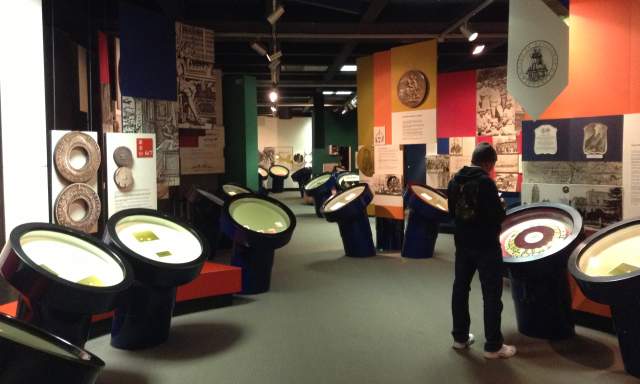
The Gold Museum, Ballarat
It's not every day that you get to see an exhibition of rare, high-quality gold coins from Australia's colonial days, but for gold sovereign dealer Eric Eigner, last April 20th was one of those days. He took some time out of his busy schedule to give us a rundown of his recent trip to the Ballarat Gold Museum.
The last time I visited Ballarat, I had not had the opportunity to visit Ballarat's famous Gold Museum, so when I was in the neighbourhood last April on coin-related business, I took a few hours off the numismatic circuit to check out the museum's legendary gold exhibition.
I hadn't heard of the museum until it was mentioned to me by one of the friendly staff at the nearby Sovereign Hill. So after spending a quick five hours exploring the mining-related demonstrations at Sovereign Hill (including an impressive $145,000 gold pour), I wandered across the car park to the building that housed the Gold Museum.
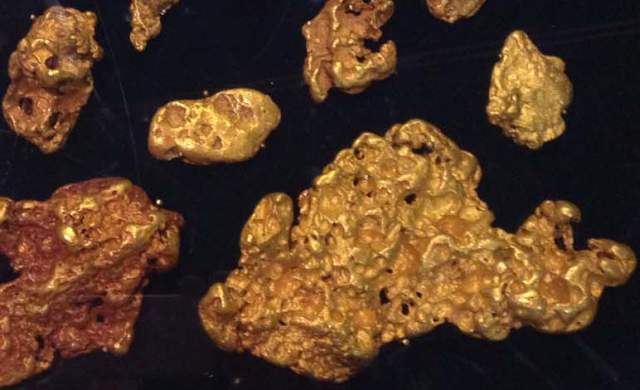
Gold Nugget Display
The first thing that met me was a roundtable display of various gold nuggets discovered throughout history. Included in the display was a very large 4.4kg nugget, discovered in 2003 in Victoria. The so-called Goldasaurus was discovered almost by accident by an amateur prospector and is one of the larger nuggets to be found in the area in recent times. There was also a range of replica nuggets, including the famous Welcome Stranger and Hand of Faith nuggets, which are on our 1987 Perth Mint gold coin sets.
I figured that there would be a gold coin display, seeing as it was a gold museum, but I was unprepared for how impressive their collection of gold coins appeared to be. (The coin collection on display at the British Museum last October was mediocre by comparison, but to be fair, the display was perhaps only a small part of their entire collection.)
The first thing I noticed was a large montage of all the different effigies of Queen Victoria, from the Banksia-wearing young queen on Sydney Mint sovereigns to the matronly Victoria that graced the Veiled Head sovereign. Beneath the montage were four actual sovereigns, each depicting in life-size the four different obverses. As a coin dealer, I noted the grades of each coin and surmised that PCGS would have graded the coins in solid Mint State grades, assuming the reverses were just as good.
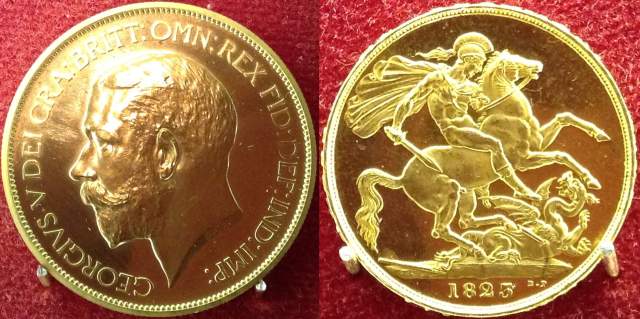
£5 Proof from the 1911 Coronation Set (left) and 1823 business strike £2 piece (right)
The next display showed eight proof gold sets from the UK, two sets of each year from 1887, 1893, 1902, and 1911. Collectors of British gold will know that these are the four years in which all four gold denominations (half sovereign to five pound) were struck in sets. I mention that that were two sets of each year, and that was so to display both obverse and reverse of all four coins. A lot of these early proofs were struck from polished dies (particularly 1902) so the coins can appear hairlined. The coins on display that day looked great by comparison.
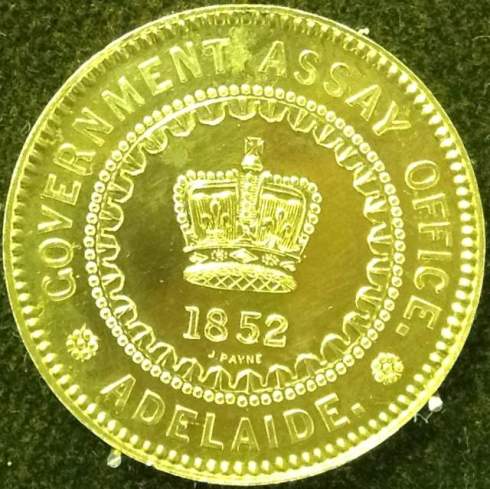
Adelaide £5 -probably gilt
Equally as notable was the display of Adelaide Pounds and Five Pounds. Curiously, there were four Adelaide Pounds -all Type II. I have a suspicion the museum had attempted to display both sides of both types of Adelaide Pound, but as the Type I is excessively rare, used a Type II instead. Meanwhile, the Five Pound was most impressive. I don't have enough experience with Adelaide Five Pounds (all of which are restrikes), but as far as I could tell, the coin looked to be either a genuine gold restrike or some kind of gilt electrotype. There were also replicas of the two types of Adelaide ingots, genuine examples of which are excessively rare.
Of course, no coin exhibit would be complete without mention of Australia's first coins: The Holey Dollar and Dump (both of which are celebrating their bicentennial this year). Although not made of gold, these coins circulated during the early years of Australia's gold rush and are worth displaying from a historical perspective. The Holey Dollar appeared to be in very good nick; the Dump, on the other hand, lived up to its name: It was very dumpy indeed. I took photos of both coins, but sadly my camera phone did not do either coin justice.
Overall, the museum was a fun way to end a long day. The exhibits are high-quality and the coins are of higher-quality still. If you're headed out toward north-west Melbourne, swing by the Ballarat Gold Museum. I spent over two hours there, but for less fanatical collectors an hour will probably be enough.
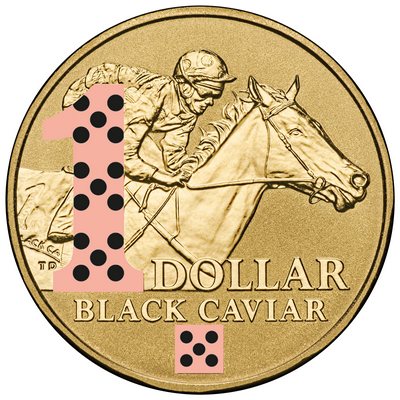
Australia 2013 Black Caviar Dollar in Aluminium/Bronze (Image courtesy www.ramint.gov.au)
On May 10, 2013 the Royal Australian Mint announced the release of two 2013 Black Caviar Dollar coins for the collector market. Just in case you've been living under a rock, Black Caviar is an Australian racehorse that retired just recently. The main claim to fame of this particular horse is that it could run fast, and as it turns out, quite a bit faster than every horse it happened to race against. The mare retired after having won 25 out of 25 short distance races it took part in. Quite a record if you happen to like horses that can run fast!
The first Black Caviar $1 coin is shown in the image above. It is a standard size and composition dollar coin, similar to what you'd see in your change. It's made from an aluminium bronze alloy, has a 25 millimetre diameter, and weighs 9 grams. This coin is going to be available with coloured pad printing showing the salmon and black jockey's silks. The coloured Black Caviar coin will be available packed into an information card depicting the horse in question. The same coin will also be available without the pad printing in a Postal Numismatic Cover (PNC). Mintages for this coin are currently unknown. The pad printed 2013 Black Caviar $1 was released at $16.95 and the PNC at $19.95.
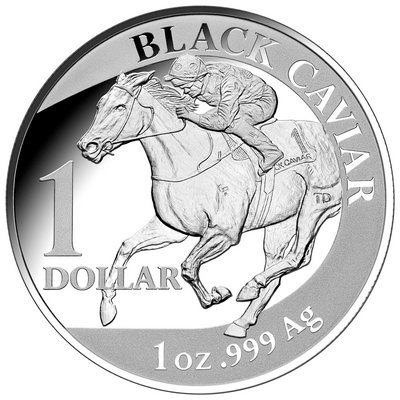
Australia 2013 Black Caviar Dollar in Silver (Image courtesy of the RAM)
The second coin release is the 2013 $1 Black Caviar Silver proof. This coin is struck in 1 ounce of 99.9% pure silver, has a 40mm diameter, and has a limited initial release of just 2500 coins. Release price for this coin was $120. It's likely that this coin will be minted again shortly as there's a cryptic mention of releasing this coin in a "Silver 2 Coin Proof Set" on the RAM website.
These coins were first made available to collectors at the 2013 Melbourne World Stamp Expo where you could also purchase couple of other new numismatic releases. To help the RAM promote the launch of these coins there was a display of the numerous trophies that Black Caviar won in her racing career (see the image below). We believe this was the first time all of the silverware had been displayed in one location. Certainly looks a lot nicer than my Under 13 Tennis Trophy.
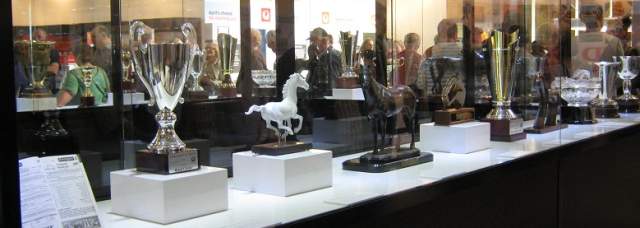
Black Caviar Trophies at the 2013 Melbourne International Stamp Expo (Image courtesy of AC)
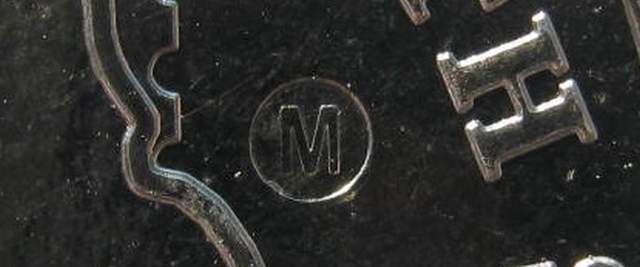
2013 100 Years of Commonwealth Stamps 50 Cent M (Melbourne) Counterstamp
(images thanks to the Blog's special friend "AC")
The mobile coin press travels right around Australia for events from coin shows to agricultural shows. Operated by the Royal Australian Mint it doesn't strike an entire coin it simply adds a type of mintmark known as a counterstamp to the reverse of the coin. Up until now it has always struck this mark onto a 1 dollar coin.
For the occasion of the World Stamp Expo in Melbourne this week the mobile or portable coin press is being used to strike an M counterstamp. This counterstamp (or specialised mintmark) is being struck onto the commemorative 100 Years of Commonwealth Stamps 50 cent coin for inclusion in a PNC. This is the first time it's been used on a fifty cent coin.
A counterstamp can be identified by a raised letter within an incuse circle which denotes that it was struck on the mobile press at a particular location -in this case Melbourne*.
A special friend of the Blog team has been to the show to bring you this process up close. The pre-struck commemorative 50c is carefully placed into the press and the Mint operator aligns the design perfectly so that the counterstamp is applied in exactly the same position on all of the coins struck. There's a screen for the public to view the process and a screen to direct that alignment for the Mint operator.
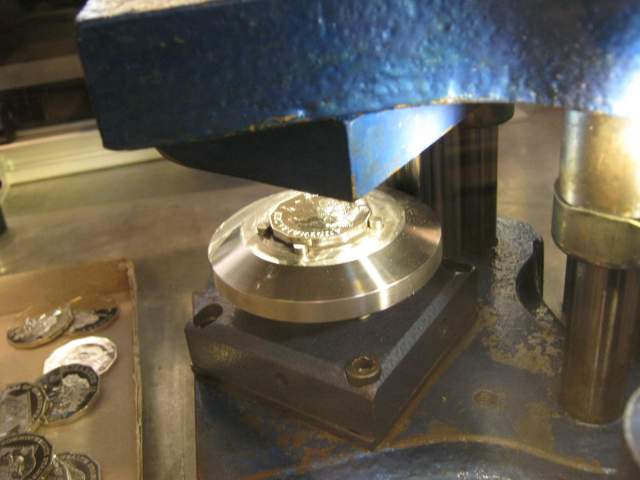
The Portable Coin Press
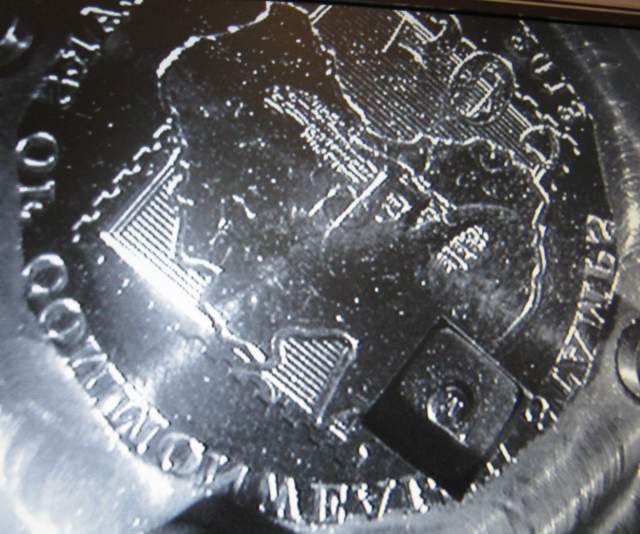
The Portable Coin Press -The Public Screen
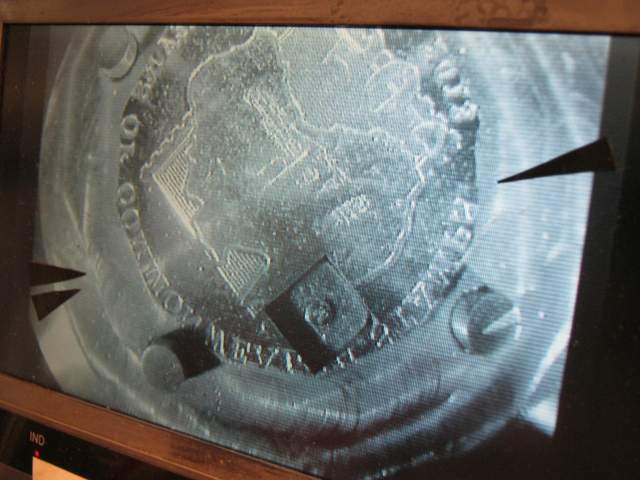
The Portable Coin Press -Operator Screen No Coin
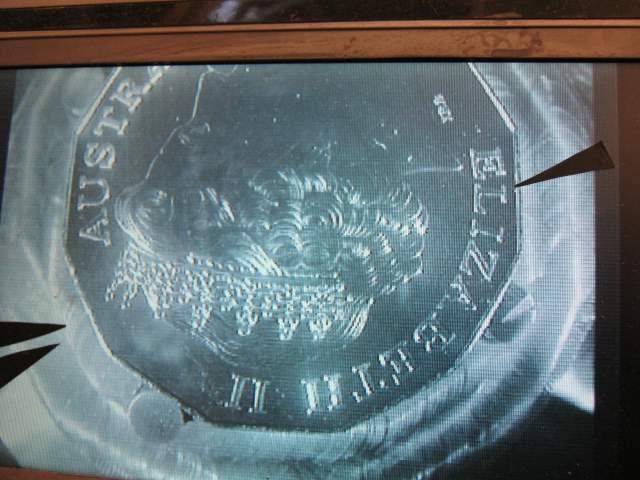
The Portable Coin Press -Operator Screen With Coin
*There has been occasions where this rule was broken when some P counterstamp 1 dollar coins were pre-struck on the portable press in Canberra before being taken to the Perth ANDA show in 2011. In 2012 all P counterstamp 1 dollars were pre-struck on the mobile press in Canberra and sold at the Perth ANDA show.
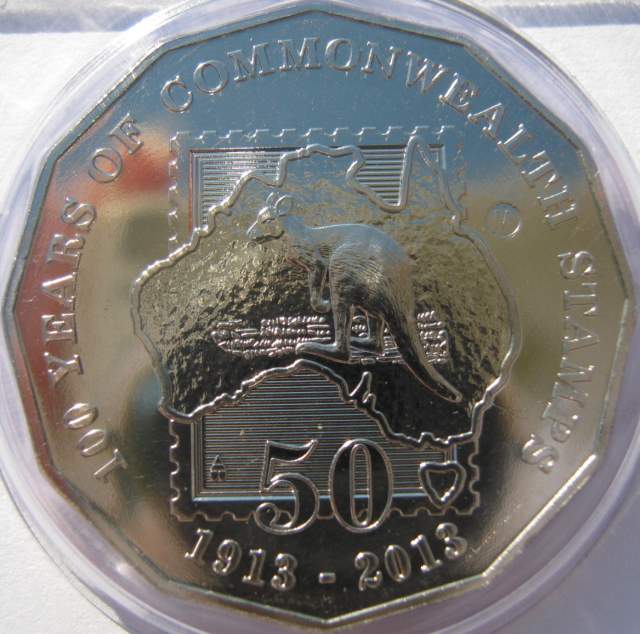
2013 100 Years of Commonwealth Stamps 50 Cent (images thanks to the Blog's special friend "AC")
The World Stamp Show is currently being held in the Royal Exhibition Building in Melbourne from 10th to the 15th May 2013. Australia Post and the Royal Australian Mint are working together to produce a limited edition daily PNC (stamp first day cover with a coin as well) for collectors to purchase during the show. Each day a different coloured foil postmark is applied at the Australia Post stand where you can make your purchase and are given a token to collect your coin to make your PNC complete.

2013 100 Years of Commonwealth Stamps 50 Cent M (Melbourne) Counterstamp
Head over to the Royal Australian Mint stand where you'll press your own M (for Melbourne) Counterstamp onto your 100 Years of Commonwealth Stamps 50c. Each day 1,250 PNC's will be issued giving a total mintage of just 7,500 M counterstamp coins in this PNC cover. Issue price is a hefty $30 each.
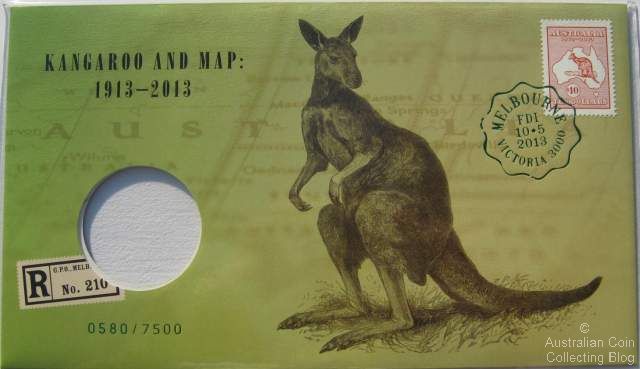
2013 Kangaroo and Map Limited Numbered PNC
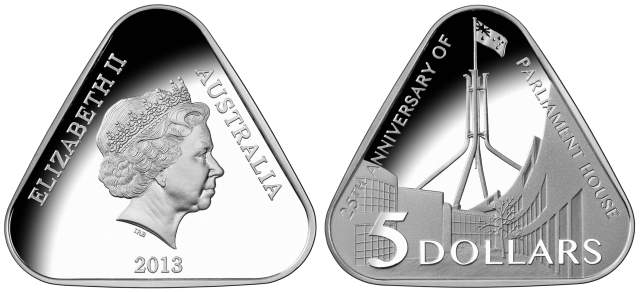
Australia 2013 25th Anniversary of Parliament House $5 Triangular Coin (image courtesy www.ramint.gov.au)
Just released by Australia's circulating coin producer, the Royal Australian Mint, this is the very first triangular shaped Australian coin. Struck in proof quality the 2013 $5 Parliament House coin commemorates 25 years since New Parliament House was opened in Canberra. At that time another $5 coin was issued to mark the opening back in 1988. That coin was a regular, round coin made from aluminium bronze that was available in both circulation and proof standards.
Demonstrating the Mint's own innovations in coin design the reverse of this new triangular coin depicts a view of Parliament House from inside one of the many courtyards it contains. The image features that major architectural achievement, the distinctive triangular flag mast that is visible from so much of Canberra. The obverse of the coin shows the Ian Rank-Broadley portrait of Queen Elizabeth II who was in Canberra to open Parliament House on the 9th of May, 1988.
Released on the 9th of May 2013, which was the 25th birthday of Parliament House, this (99.9%) fine silver proof 2013 5 dollar Parliament House coin was issued for $85 with a capped mintage of 10,000 coins. For the more budget conscious collector the RAM has also released a 20c coin celebrating the same anniversary. The 2013 Parliament House 20c is available for the more budget minded collector for just $8.
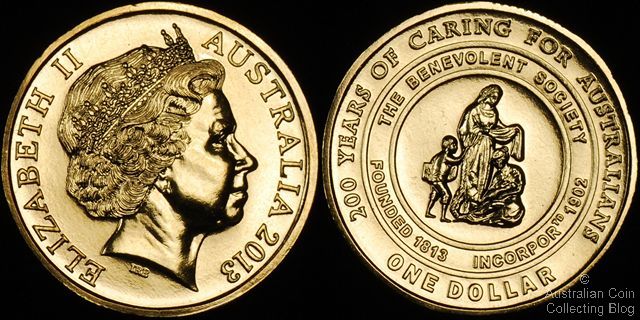
200 Years of Caring for Australians, The Benevolent Society 1 Dollar
To be honest the issuance of this coin has opened my eyes. A society that I'd not heard much about, Australia's first charity the Benevolent Society celebrates it's 200th year in 2013. The role this society has played in Australia being what it is today is paramount. It's been at the forefront of changes in attitudes and practices helping those most in need.
Originally named the 'NSW Society for Promoting Christian Knowledge and Benevolence', it was founded by Edward Smith Hall on 8 May 1813. Mr Smith was involved in forming Australia's first bank, the Bank of NSW (now known as Westpac) and was its first cashier and secretary. The Benevolent Society's purpose was to 'relieve the poor, the distressed, the aged, and the infirm.' Today, among a myriad of ways the society helps the community the society helps families and parents and offers foster carer support. They help the aged live confidently and independently into their retiring years managing those health challenges we'll all face.
One of the main purposes of the Royal Australian Mint is to promote historical events through the striking of special commemorative coins. This 1 dollar coin features an interpretation of the Society's original logo on the reverse with the obverse depicting the Ian Rank-Broadley portrait of Queen Elizabeth II. It is the standard 25 millimetre diameter and weighs 9 grams. It's struck in aluminium bronze as a regular dollar but won't be found in change. It's been issued in a collector card as non-circulating legal tender.
"The Royal Australian Mint has a proud tradition of recognising the different attributes that have helped make our society what it is today, and The Benevolent Society is an important part of that social tapestry," said Royal Australian Mint CEO Mr Ross MacDiarmid.
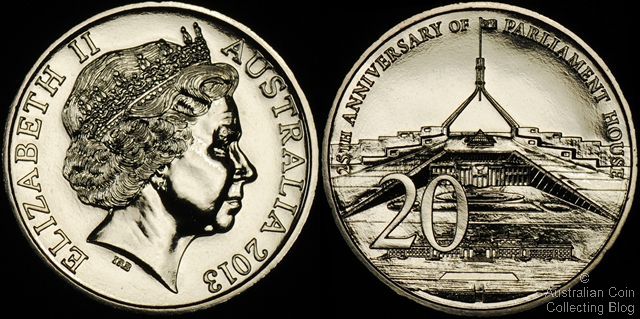
Australia 2013 25th Anniversary of Parliament House 20c
Not content with bombarding the coin collecting community with commemorative 50c and dollar coins the Royal Australian Mint has decided it's onto a good thing and is really ramping up the production of non circulating legal tender 20c coins. In the image above you can see the latest of these, the 2013 Parliament House 20c designed to celebrate the 25th anniversary of the opening of the new parliament house which was opened for the bicentenary of Australia in 1988. While the cynical side of me would prefer a coin celebrating the burning down of parliament house (while most of our politicians were in it) there's no denying the reverse design of the coin is both intricate and spectacular.
The obverse of the coin has the Ian Rank-Broadley portrait of the Queen that we're all used to. The excellent reverse was designed by Tony Dean (designer of the 2007 Lifesaver Dollar) who we interviewed a few years ago in his studio. The reverse depicts the current Australian Parliament House which was built into Capital Hill in Canberra, ACT and opened in 1988. At the time, the opening of the new house for our parliament was a keystone of the year long bicentennial celebrations of Australia. In the foreground of the design is a depiction of the Old Parliament House building. The standard size and composition 20 cent wont be found in your change (unless someone spends one by accident) and was released in an information card by the RAM for $8. It's also available in an Australia Post PNC.
This isn't the first time Australia's parliament has appeared on a coin. The first, of course, was the old Parliament House that appeared on our first commemorative coin, the 1927 Parliament Florin. This is a beautiful and collectable coin. The second time Parliament House appeared on a coin was in 1988 on an alumunium bronze $5 collector coin. That coin is ugly, unloved and best taken to the bank and cashed in for $5 you can spend on something more useful. Let's hope this 2013 Parliament House 20 cent proves to be more successful and loved by coin collectors.
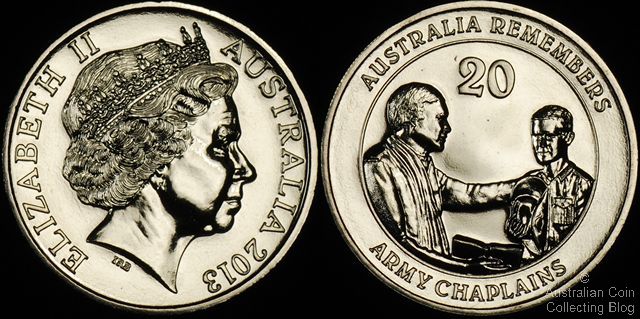
Australia 2013 Royal Australian Army Chaplains 20c
Above you can see the 5th in the series of "Australia Remembers" 20c coins issued by the Royal Australian Mint (RAM). The 2013 Army Chaplains Australia Remembers 20c coin, issued on the centenary of the founding of the Royal Australian Army Chaplains Department, is dedicated to the chaplains who have served in the Royal Australian Army since that time. The coin, despite being the standard copper / nickel composition of the normal circulation 20 cent coin and the regular 11.30 grams won't be found in your change, and is available encased in a protective capsule set into an information card issued for collectors.
There were chaplains present in the soldiers who embarked on the first fleet to Australian in 1787 but it wasn't until 1913 that the Royal Australian Army Chaplains Department (RAAChD) was founded officially with the appointment of 4 chaplains general. As of 2012 there were 150 army chaplains (or "padres") in service in the Australian army. According to the official website of the RAAChD the role of army chaplains is to:
"advise commanders and their staff on religious, spiritual, moral, ethical, cultural and welfare matters, to provide pastoral care to soldiers and their families, to provide advice to the chaplaincy chain of command and to coordinate and lead chaplaincy activities within units."
The obverse of the coin bears the standard depiction of Queen Elizabeth the Second as sculpted by Ian Rank-Broadley. The reverse of the coin shows a chaplain with an open Bible reaching out to a Digger who holds his characteristic slouch hat to his chest. The reverse was designed by Anna Meszaros, the grand-daughter of well known sculptor Andor Meszaros who designed the 1967 Pattern Swan Dollar.
The 2013 Australia Remembers Royal Australia Army Chaplains 20 cent will be produced on demand by the Royal Australian Mint so the final mintage will not be known for another year or two. Those interested in collecting the rest of the Australia Remembers 20c coin series should take a look at our other articles on the series. These are the Australian Service Nurses 20 cent, the Lost Soldiers of Fromelles 20 cent, the War Historians 20c, and the Merchant Navy 20 cent.


